I never mentioned your name, did I?
I never mentioned your name, did I?
Now you didn't, and my response was not in frustration, anger, or any other negative intent. Sorry if it appeared so. I merely wanted to point out the advantages of "recycling" old Super's that have no future in restoration. The OP's camera, even though, frustrating short of parts to make a full blown hand held rangefinder camera, can still do duty as a Ground Glass viewing piece of equipment.
In fact I contacted the OP to see what he may do with the SG he received. I am well into my second ISG-Lite (Improved Super Graphic Lite) and need a few parts that are not related to the rangefinder, solenoids or electronics. Hell, I can't even tune my VCR to the stations... not an electronics guy here.
So, not offended, and "Madly" Yours... Lars
Your response was perfectly appropriate and welcomed. I've always held back from discussing stripping down SGs only because I have no experience or interest in doing so, so I'm glad you spoke up on that topic. I totally understand why people might do such a thing. I was teasing you.
Intensity is part of the are that drives us. Be is intent as you like. I go to war fitting with even the smallest problem. Wasteful of resources but fast..... people I give slack. We all struggle against the ho hum nature of ' the entertain me' crowd.
The diode in the circuit is to suppress the transient reverse voltage from the solenoid when it de-energizes. This prevents the high voltage pulse from arcing across the button's contacts and protects the capacitors from damage.
To test my solenoid, I clipped together five regular 9-volt batteries in series and used some clip leads to connect to the battery compartment. Watch the polarity! Sometimes the wires running through the Super Graphic bellows break and are nearly impossible to repair. Mine worked great, so I ordered some cheap carbon zinc cells from China on Ebay.

Last edited by dfroula; 9-May-2017 at 06:58.
BTW, the service manual schematic notes mention there are 2-80 microfarad capacitors in the solenoid triggering circuit and two capacitors are shown in the schematic. This is misleading, as the note applies to EACH of the symbols. There are actually FOUR 80 microfarad capacitors in parallel for a total capacitance of 320 microfarads. That's what I measured with my capacitance meter.
The service manual indicates there should be no more than 25 microamps of current leakage when the camera is just sitting. There is no on/off switch to disconnect the batteries, so the batteries will slowly discharge. The original Eveready carbon zinc battery had a capacity of 140 mAH. That equates to 140/.025 or 5600 hours of standby life, worst case. That's just under a year before the expensive batteries discharge just sitting in the camera. I read 15 microamps leakage on my meter, which is 388 days of standby life. I recommend removing the batteries when not in use!
Capacitors sometimes develop excessive leakage as they age, so it is good to verify your camera draws 25 microamps or less before investing in the batteries. Just connect a multimeter in series with the test batteries, as described below.
It is possible to hot-wire 5 9-volt batteries clipped together in series to the shutter circuit by using an external resistor. Connect the negative side of the battery stack to the right terminal of the flash socket on the camera body through a 2.7 kohm 1/2 watt resistor. Use a finishing nail or 14 gauge solid wire as a contact post. Connect the positive side of the battery stack to the lower terminal on the right rear bottom of the lens standard. Look for two small nuts holding wires from the shutter. These are the terminals from the solenoid. Don't omit the resistor or the capacitors and/or solenoid may be damaged. This method of testing bypasses the internal resistor, so you must supply one. Works great for testing. You can verify my connection suggestions by referring to the schematic.
The batteries can be quite weak and still function, as the capacitors store the energy needed to trip the solenoid. It will take longer and longer to recharge the caps between shutter activations as the batteries age, however. The internal resistor limits the recharge time and limits the current from the battery when the shutter is tripped.
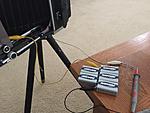
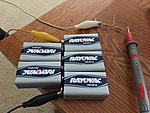
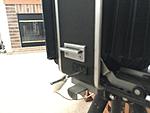
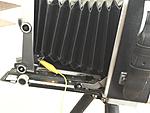
Last edited by dfroula; 9-May-2017 at 08:10.
The blue Graflex BC flash adapter has one of the 22.5 volt batteries (same as used in the Super Graphic) and a 10 Kohm resistor disk built into the battery holder to limit the current from the battery. It replaced two D cells and provided much more reliable operation than D cells that were weak.
The adapter had no capability to power the shutter in the Super Graphic. It simply flashed the bulb when triggered by the shutter contacts, routed through the bellows and camera body to the three pin socket on the side of the camera.
The circuit is nearly identical to the Super Graphic shutter circuit, just optimized to fire a flash bulb instead of triggering a solenoid.
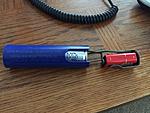
I had an idea to make up 3 stacks of 5 each CR2032 lithium coin cells, connected in series with copper strips. The size should fit inside the battery compartment. I would fabricate a plate from circuit board material to match the battery contacts in the compartment. CR2032 cells can be had for 6.00 USD per 20 count. The battery capacity is 220maH, where the original battery was 140maH, so battery life should be very good. Ordered the batteries from Amazon and going to give it a try.
I'd be interested in the details of both your design and experiment.
I'll be sure to post results. I have a brief video of my hotwired shutter test here. Note how the current peaks at about 20mA when solenoid is triggered (checked with peak hold feature on meter) and decreases to a steady 15 microamps at the time constant determined by the resistor and capacitor combination. The internal resistor is wired to only limit current from the battery for charging caps slowly, as the original batteries had such a high internal resistance they had no hope of triggering the solenoid alone. The capacitors stored the charge and dumped it into the solenoid with very low resistance when the button was pressed:
Last edited by dfroula; 10-May-2017 at 21:13.
Bookmarks